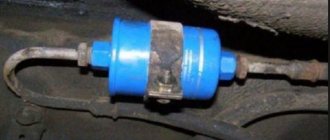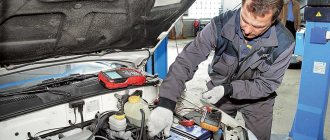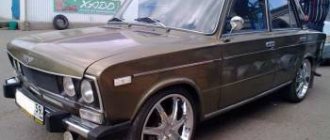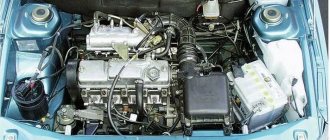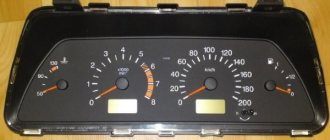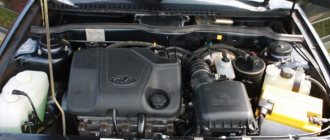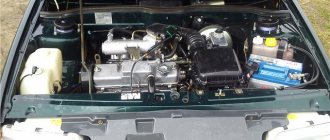Guys, I'll be brief:
Given: NIVA (21214), injection, 2002. Problem: it grabs, but won't start. More details: the car sat outside overnight in the now famous Moscow frost, came out in the morning, the battery turned the starter, the car sneezed, but did not start. When trying to start (the clutch pedal is pressed), I also tried to press the gas pedal before ignition, turn on the ignition for 3-5 seconds, turn it off, slowly release the gas pedal - they say that something is blown out of the injection NIVA. Oil 10w40. I assume that it may be very close to the minimum. I noticed another pattern - the more you turn the starter, the more often the car sneezes and sometimes it even seems like it’s about to start... but it doesn’t start. The battery runs out earlier.
What I tried to do: 1. Heated all the spark plugs and cleaned them with sandpaper. I don’t remember any further of the modification A. spark plugs. 2. I topped up with 95 gasoline from a proven gas station (there was a suspicion that the day before I filled it up with 92 gasoline in the form of a complete mess). 3. I tried to light a cigarette for others - the same problem - the starter spins (I tried turning the starter from 1 second to 5 seconds continuously), the car sneezes, but does not start. 4. Tried to start from the pushrod - zero success. 5. Cleaned the contacts of the Varta battery (62 Ampere). Charged the battery.
Damn... who can explain to me what the problem could be?
It happens that the starter works fine, but the engine stubbornly refuses to start, although the Check lamp does not light up. In such cases, if we talk about the VAZ-2123 engine, we can immediately name 10 different reasons. All of them will be quite real, and not at all from the category of “contacts have oxidized.” In general, sometimes the Chevrolet Niva does not start, but the starter turns the shaft properly, and the reason should not be looked for there. Well, let's try to learn to recognize different reasons, that is, to distinguish one from the other.
Example in the video: the APS immobilizer blocked the engine because it was in learning mode!
Chevrolet Niva does not start: three different sensors
The crankshaft position sensor will not indicate its failure in any way. The Check light will not light up, the engine will simply not start. Finding this sensor is easy if you know where the alternator belt is (see photo).
DPKV sensor connector
Here we check the serviceability of the wiring, as well as the distance from the sensor to the “teeth” (0.8-1.2 mm).
The second suspicious element will be the temperature sensor. The engine may not start only if it breaks. In this case, the electric fan should work without turning off. That is, a break in the DTOZH sensor circuit is easily recognized.
Element “6” is DTOZH
In the photo there is a sensor, and to get to it, the air duct is removed.
If the idle speed control malfunctions, the engine on a Chevrolet Niva does not start, but the starter turns. By the way, the Check lamp may be on. Diagnostics:
- Just lightly press the gas and turn on the starter;
- If the engine starts, but without gas it does not start, it means the IAC is faulty.
Problems with the relay or battery
If, when you try to start a Priora car or a car of another brand, you hear a click, but the starter turns very slowly, you need to clean the nickels. In some situations it may be necessary to solder a new contact layer. If you suspect that the cause is in the motor, you need to close the contacts in the relay. If after this the engine was able to start the first time, look for the cause of the malfunction in the relay. Otherwise, the cause lies in the engine itself.
Often this problem occurs due to a fault in the relay. This is evidenced by the occurrence of several clicks that occur one after another when trying to start the car. If you listen, it becomes clear that this sound is made by a relay. It occurs due to the fact that the starter receives an electrical charge, but the current only reaches the traction relay and does not reach the engine spin-up mechanism. In this case, you can immediately rule out the version of a discharged battery, since due to the low charge, the starter would still be able to turn, but slowly and only a few times.
Set of "electrical" reasons
The first step in diagnostics: remove the cap from any spark plug, install spark plug A17DVRM and, holding it with pliers, turn on the starter.
How to remove the cap
The spark plug must be held by the hexagon, the pliers must have insulated handles, and the spark plug body must touch the “ground”. As a result, a spark can be observed. If there is no spark, it means:
- The ECM is faulty or is not receiving voltage;
- The ignition coil module burned out;
- High voltage wires are faulty.
The drawing for point “1” is given below.
Power supply point to the ECM
The presence of a spark “in the air” does not guarantee its presence in the engine. The spark plugs may be faulty, the gap may be incorrect, etc.
The number of reasons why the Chevrolet Niva does not start, but the starter turns, has increased to 7.
Immobilizer blocks engine starting
If the immobilizer has been activated, then sooner or later it will block the engine from starting. It happens like this: when you turn on the ignition, the indicator flashes for 15 seconds, then goes out. And then the system produces sound signals.
“2” – immobilizer lamp
The APS-4 module can be disabled. For this you need a “red” training key. Well, the APS-6 unit cannot be turned off. Usually you have to flash the ECM.
There is no need to panic right away: perhaps the blocking occurs due to irregularities in the “reader” wiring.
Silence when trying to start the engine
The Niva crankshaft cannot be turned by the starter.
There may be several reasons:
- Blown fuse.
- Poor contact between battery terminals.
- The battery is completely discharged.
- Failure of the starter solenoid relay.
- Failure of the intermediate relay that switches the starter circuit.
First of all, you should pay attention to the dashboard. When you turn on the ignition or the main electrical circuit in the engine, the lamps should light up on the dashboard or information should appear on the on-board computer, if we are talking about the Chevrolet Niva
If this does not happen, the cause should be sought in the fuse box and in the battery contacts. During operation, oxides may form on these contacts, increasing the resistance. Loose contact connections can lead to sparking and burning.
If no blown fuses are found, you should check the reliability of the “+” contacts of the battery with the central wire and the “-” contacts with the vehicle ground.
To eliminate the malfunction, be sure to replace the fuses and clean the contacts. It would be a good idea to acquire even the cheapest tester in order to quickly check the presence of voltage in the electrical circuits of the car.
Fuel rail
On the ramp next to regulator 5 there is a control fitting 3. It is closed with a cap, which is unscrewed and then carefully pressed on the spool.
If fuel flows, it means it is entering the ramp. But perhaps the necessary pressure is not created. Reasons: clogged filter cylinder, pump malfunction, etc.
The pressure should be 350 kPa (3.5 bar). It is controlled by unscrewing the spool and installing a pressure gauge. Before checking, you need to reduce the pressure!
If fuel does not flow, notice whether the pump turns on when the key is turned to the “I” mark. When the ignition is turned on “cold”, the pump should run for 10 seconds.
Additional mounting block
Know that fuse F2 and relay P4 are responsible for turning on the pump. There is also a main relay P5, and all these elements are located in a block mounted on the same bracket with the ECM (see photo).
Even if the pressure is normal, the injectors may be clogged. In addition, their wiring may be damaged.
Case from practice
What happens if water gets into gasoline? In the summer - nothing. And in winter, the power supply system can become clogged with ice. All elements are at risk, from the pump to the injector valves!
Fuel supply line filter
A small amount of water is always present in fuel. If this number is increased, this is what happens:
- The first start always goes without problems;
- Then, after leaving the car in the parking lot, after 2-3 hours the owner will no longer be able to start the engine without repairs.
All of the above applies to any injection internal combustion engine, including the VAZ-2123. And the “first candidate for failure” will be the fuel filter. It is located under the bottom of the Chevrolet Niva and is encased in aluminum (see photo). However, this is done on many cars.
Pumping up excess air
One smart book says that the engine may not start due to the fact that the intake manifold draws in too much air. This means you need to check the fastening of all pipes. But not only.
Vacuum brake booster
The source of “excess air” may be a faulty VUT. The starter turns, the engine on the Chevrolet Niva does not start, and the reason, it turns out, must be sought in the brake system!
Starter problems
When the battery has a good charge and the immobilizer is disabled, the engine cannot be started - this is direct evidence of a starter malfunction. If, when the ignition is turned on, the starter motor does not start, and characteristic clicks are heard, this indicates that only its traction relay is activated. The appearance of a loud knocking sound in the engine compartment indicates that the starter retractor relay is faulty, due to which the bendix and flywheel do not engage with each other, making it impossible to start the car engine. You can diagnose this retractor malfunction and start the power unit by closing both contacts on the relay using a powerful screwdriver with a well-insulated handle.
Important! Before performing this procedure, the vehicle must be in neutral. If the start is successful, then the retractor is faulty
Perhaps the reason lies in the burning of his nickels. Most car owners think that this starter element is not repairable, and if it fails, only replacement will save the situation. It is enough to remove the relay, then disassemble and remove the round nickels, which must be cleaned with sandpaper, assemble the device and install it back. Please note that the nickels have a special anti-corrosion coating, so sanding them is only a temporary measure
If the start is successful, then the retractor is faulty. Perhaps the reason lies in the burning of his nickels. Most car owners think that this starter element is not repairable, and if it fails, only replacement will save the situation. It is enough to remove the relay, then disassemble and remove the round nickels, which must be cleaned with sandpaper, assemble the device and install it back. Please note that the nickels have a special anti-corrosion coating, so sanding them is only a temporary measure.
If the starter does not work, there is probably no voltage being supplied to its terminals. The engine starting system of most vehicles is equipped with a special relay, the purpose of which is to reduce the starting current. It may suddenly stop functioning, making it impossible to supply voltage to the starter terminals. A temporary solution to this problem on the road will be to install any similar element, for example, a rear window heater relay.
Wear of the starter brushes is also the reason why the engine cannot be started, or it will start only once in a while. Burning or short-circuiting of the winding turns completely disables the element. In this case, you cannot do without replacing it. The shaft of the part may also jam, for example, due to wear of its bearings or misalignment.
Video diagnosing the causes of an uncertain cold start
Along with high efficiency and relative reliability, fuel-injected cars have one unpleasant drawback - the difficulty of repair. It happens that the injector suddenly stops starting, and it becomes difficult to do anything with it. It’s good if you have the opportunity to call a tow truck or show the car to a professional, but what should those motorists do who are left with the problem alone? Let's figure it out by examining in detail all the reasons why the injector starts poorly or refuses to start at all, as well as how to “treat” such a malfunction.
Brushes and winding
Inside the starter housing there are 4 steel cores (shoes) with a winding that is connected into a circuit.
Healthy! Some cars do not use cores with windings, but magnets, which is much more convenient.
The current to the winding comes from the central input, and the output is output to two copper-graphite positive brushes that go to the commutator. Also connected to it are negative brushes that come from the starter mass. All brushes are constantly pressed using small springs. But, since graphite is not the most durable material, these elements tend to wear out quite quickly. When brush wear reaches a critical level, the solenoid relay stops receiving current.
In the event of such a breakdown, the starter will not make any extraneous sounds. To repair, you will need to disassemble it and evaluate the condition of the brushes. If everything is in order with them, then we look at the windings. If they burn out, the layer of varnish that is applied to them will also burn out. Also, instead of copper color, the windings will be black.
Possible faults
No matter how trivial it may sound, if the injector does not start, it means something has gone wrong. The success and speed of repair depends on how quickly and efficiently the problematic link in the car’s design can be identified. To better understand the essence of repair activities, it would be a good idea to pay attention to potential breakdowns. The basic list of the latter is as follows:
- Malfunctions of the injector itself. In the event of a breakdown of this kind, as a rule, the car does not start either cold or hot. On top of that, the injector indicator on the dashboard or on-board computer constantly lights up, signaling its malfunction. It is much less common for the engine to work when the indicator is on, but in this case the car starts poorly and is extremely unstable. It is worth noting that the injectors in the injector most often become clogged or the ECU burns out, so it is advisable to check these components first;
- Ignition system failures. Here the list of possible faults is quite large. Often the candles that suffer are simply flooded. In the event of such a breakdown, the car starts and immediately stalls, but in the long term it stops even “grasping.” Other components of the ignition system (coil, module, distributor, crankshaft sensor, etc.) are noticeably less likely to suffer;
- Incorrect operation of the fuel system. In this aspect, injection engines most often suffer on three fronts:
- Fuel filters are clogged (the car “picks up”, but does not start; if the engine starts, it is extremely unstable);
- The fuel pump is faulty (its characteristic operating sound is absent when you turn the ignition key, the injector itself simply does not start both cold and hot, the starter turns).
- There is insufficient pressure in the fuel system (the engine starts up reluctantly both cold and hot, but if it starts working, it functions unstable);
- Engine problems. Perhaps the widest range of possible malfunctions. Often the reason lies in weak compression or incorrectly adjusted valves. In any case, with a “motor” starting problem, high-quality engine diagnostics are required, otherwise it will be very difficult to determine the cause of the malfunction.
In addition to the breakdowns described above that can break the operation of the injector, the problem may lie in more trivial things. An example of this is a weak battery charge or lack of fuel in the tank. Considering just such incidents, before repairing a car, it is extremely important to exclude the possibility of their occurrence, so as not to waste extra time and nerves.
Description of problems with the starter and ways to solve them on the VAZ 21213
On Niva, most of the components are quite reliable and do not require frequent repairs. But there are a number of standard breakdowns characteristic of the vehicle in question. Most often, the starter does not turn for the following reasons:
- turn-to-turn short circuit in the solenoid winding - the relay needs to be replaced;
- open circuit of the power supply - it is necessary to check the connections between connections No. 50 and No. 86 (the most common places of oxidation);
- the relay armature is stuck - it is necessary to replace the armature.
If the solenoid relay is activated, but the starter does not rotate or rotates very slowly, then you must:
- poor contact on the tips and terminals of the battery - it is necessary to stretch it and clean it from deposits;
- the commutator contacts are burnt, the brushes are stuck - you need to clean the commutator and replace the carbon brushes;
- there is a short circuit in the brush holder - it is necessary to replace the cover on the commutator side.
Sometimes it happens that the starter rotates. But the engine flywheel remains motionless. Perhaps the reason lies in clutch slipping. To determine the exact cause and repair, you will need to remove the starter and check it on the stand. The problem can only be solved by replacing the coupling. Sometimes extraneous noise occurs when the starter rotates. The reasons for this may be the following:
- The bearing bushings and armature shaft journals are worn out – the starter needs to be replaced;
- The starter is loose.
To solve most problems that arise during operation, you will need to remove the starter. This procedure may require dismantling the injector. Testing at the stand will not take much time. But it will allow you to determine the exact cause of the malfunction. There is a wide range of breakdowns. They usually occur on cars with mileage of more than several tens of thousands of kilometers.
The procedure for returning the car to “life”
Let's say you find yourself in circumstances where the injection engine starts poorly or refuses to do so at all. There is no need to hesitate in such a situation - it is advisable to immediately begin resuscitation procedures. If you don’t have time to figure out the exact reason why the car doesn’t start well, then you should quickly carry out the following algorithm of actions:
- First of all, we check the availability of gasoline and battery charge. Is there something missing? Fill it up and light it up. Let's try to start. If there is no result, proceed to the next step;
- Next, we quickly analyze under what circumstances the car malfunctions. If it takes a long time or is difficult to start when hot, we first check the spark plugs for overheating (light carbon deposits) and the functioning of the fuel system. Otherwise, when the car malfunctions both cold and hot, a more comprehensive approach is required. As a rule, the following procedures are sufficient: checking spark plugs, wiring the ignition system, assessing the operation of the injector and fuel system;
- Note that most motorists manage to solve the problem, so to speak, with little loss, that is, by implementing the actions described above. If you are not one of the lucky ones and your car still takes a long time, starts poorly or refuses to work at all, you will have to act globally. Here it is better to take the car to a service station or a convenient garage and check the compression, timing adjustment, clean the injector, assess the condition of the fuel system and ignition devices. If there are any malfunctions, they must, of course, be eliminated.
Ignition system is faulty
Another main obstacle to starting a VAZ 2121 gasoline engine is the ignition system. Malfunctions in the heating system of a diesel engine can also make it significantly more difficult, and in cold weather, completely impossible to start it.
If a gasoline engine does not start, you should first check for high voltage on the center wire, or on the spark plugs with a separate ignition system without a distributor.
If the car has a contact (battery) ignition system, you should check the gap between the contacts, the condition of the cam, and also the capacitor. If the gap between the contacts does not correspond to the required value or the capacitor is shorted to ground, the reason has been found!
In other cases, you should definitely check the wires, distributor cap, and spark plug insulators for high voltage leaks. If there are black carbon tracks and cracks on the surface of these parts, they must be replaced.
The Niva's non-contact ignition system is checked in the same way.
Particular attention should be paid to the spark plugs. There should be no traces of soot, soot, or oily deposits on the surface of their electrodes.
Only the presence of a gray or brownish-red coating is allowed, which appears as a result of the combustion of various additives in gasoline.
You should also pay attention to the gaps between the central and side electrodes. Typically, the gap should not exceed 0.7 - 0.8 mm
Other parts, for example, quenching resistors and silicone wires should not have a resistance higher than 15 - 20 kOhm. When identifying the cause, also pay attention to the condition of all contacts, the presence of moisture and condensation.
The main difficulty when starting a diesel engine with a known good fuel supply system is faulty glow plugs. To check them, just turn on the voltage supply to them for 10-15 seconds, and then try to start the diesel engine. Glow plugs with a burnt-out spiral are quite difficult to distinguish from serviceable ones, so they must be identified by their electrical resistance. If the spark plug resistance is too low (1 - 5 ohms) or tends to infinity (several megaohms), the spark plug must be replaced.
Prevention of injector breakdowns
Why the injection engine does not start and how to eliminate possible problems is now known to all readers of our resource. However, it is better to avoid such breakdowns, so let’s pay attention to ordinary procedures that, if carried out systematically, will help minimize the risks of all malfunctions. The simplest but most effective prevention consists of the following measures:
- Firstly, refuel exclusively at proven gas stations and only with high-quality fuel. Remember that most fuel system and engine malfunctions are caused by dirty gasoline;
- Secondly, change all consumables on time and only with high-quality products. The most important thing is periodic replacement of all kinds of filters and engine oil;
- Thirdly, periodically check the main components of the machine for stability. The list of the latter, naturally, includes the injector, elements of the fuel system, ignition and engine;
- Fourthly, never neglect routine diagnostics of your car at a service station. Surprisingly, even a delay of a couple of hundred kilometers can cause serious damage, which previously could have been eliminated with very simple actions;
- And fifth, always operate your vehicle properly. That is, you do not need to overheat, overload or negatively impact your car in any other way.
Perhaps this is where the most important information on today’s issue has come to an end. We hope the material presented above was useful and provided answers to your questions. Good luck in operating and maintaining your car!
Relay replacement
The principle of repair and replacement of switching units is identical regardless of location
It is important to disconnect the battery before working with them to avoid electric shock and injury (possible death). The process of replacing the unit responsible for controlling the light and heated rear window (for example):
- Use a Phillips screwdriver to disconnect the block.
- Remove the starter and ignition switch under the additional set of fuses.
- Using the same screwdriver, unscrew the fastening screw.
- Disconnect the connectors after removing the switch.
- Install the replacement in reverse order.
Where is the Niva starter relay located?
VAZ (Lada) 2121 (4x4) 1993 - present
Help me determine the location of the starter relay on a Niva.
- The starter, when starting, is disconnected from the flywheel - 3 answers
- Niva 2121 won’t start – 11 answers
- VAZ 2121 starter does not work - 3 answers
- Why don’t the starter relay and fuel pump relay work, Niva 2121? – 3 answers
- The generator does not produce the norm at 14.2-14.5 on Niva - 2 answers
You can determine the location of the starter relay on a Niva using your ears. You take it and listen to where the clicks are heard.
Well, if anything, the starter relay is located behind the upholstery, just to the left of the left leg, under the additional fuse block
To change the relay, you need to unscrew the fastening screw, remove the relay and disconnect the block.
Even more useful tips in a convenient format
The starter, when starting, is disconnected from the flywheel
voice
Article rating
